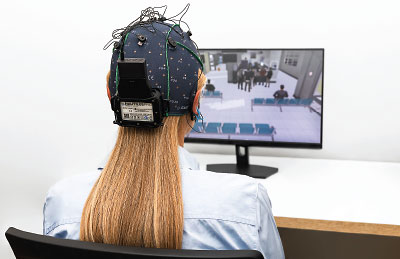Earlier this year the digital health technology company GrayMatters Health announced that it had received clearance from the Food and Drug Administration (FDA) for its product Prism—a noninvasive neuromodulation device for posttraumatic stress disorder (PTSD).

The device is based on the principle of neurofeedback—a method of training individuals to focus their thoughts and attention in a way that modulates their brain activity.
People receiving neurofeedback training typically wear a cap covered with electrodes that records their brainwaves (electroencephalography or EEG) while they train. The EEG readouts are then converted into an audiovisual format as feedback to assist the training; for example, if the participant activates the brainwave of interest, a signal on a computer screen will appear.
“The purpose of this treatment is to strengthen the circuitry of emotional regulation, through exercising that circuit like a muscle,” said Charles Marmar, M.D., the Lucius N. Littauer Professor and Chair of Psychiatry at NYU Langone Health.” Marmar led an open-label trial of Prism in patients with PTSD at NYU Langone. He has no financial ties with GrayMatters Health.
EEG neurofeedback, which targets broad patterns of brain activity, has been used for decades to treat conditions such as anxiety and attention-deficit/hyperactivity disorder. Oded Kraft, co-founder and CEO of GrayMatters Health, noted that Prism differs from earlier neurofeedback approaches by targeting a specific brain circuit that has been shown to malfunction in people with PTSD.
Prism users learn to control key neural connections between the amygdala and frontal cortex to boost their emotional regulation and stress resilience. (This neural biomarker, known as an electrical fingerprint, was identified via functional magnetic resonance imaging data by Talma Hendler, M.D., Ph.D., a professor of psychiatry and neuroscience at Tel Aviv University and founding director of the Sagol Brain Institute.)
To target this pathway, Prism participants watch a monitor while EEG readouts are recorded. The video shows a noisy hospital waiting room full of moving avatars; participants are told to find thoughts or feelings which connect to the desired neural pathway, and as they do, the animated figures begin sitting down and staying quiet.
Prism’s “exercise routine” consists of 15 30-minute training sessions completed over eight weeks; each session includes multiple rounds of the standing and sitting simulation. Participants are given very basic instructions and it is up to them to identify the right mental state that alters their electrical fingerprint.
“People get amazed when they see themselves controlling something with their brain,” Kraft told Psychiatric News. “But the treatment also lets them see the association between their mental state and brain state. They understand what their brain connections are like when relaxed versus when stressed.”
Critically, the neurofeedback process teaches people a useful skill to help regulate their emotions outside of a treatment session, Kraft continued.
“There are very few neuro-anatomical based treatments in psychiatry,” Hendler said. “Every time you learn something in Prism, your brain is learning as well—neurons are making new connections and circuits are being rewired. We’ve seen in the laboratory that changes spread beyond the amygdala and go throughout the brain.”
According to GrayMatters Health, the FDA granted medical device clearance to Prism based on the results of an open-label clinical trial involving 79 adults with PTSD. Though the study data have not been published yet, both Kraft and Marmar noted that the trial demonstrated that eight weeks of Prism therapy significantly reduced PTSD symptoms with minimal adverse effects, and that these improvements were maintained after three months.
Kraft said Prism will be available as a prescription-based adjunct intervention for PTSD. Any interested clinics pay an initial cost to purchase the EEG-based console, followed by a subscription fee for each session; patient data will be available to prescribing physicians. Kraft added that in addition to the 15-session core intervention, the FDA cleared Prism to provide booster sessions if needed.
“Our objective is not to go around the psychiatrist or therapist,” Kraft said. “We wanted to add something useful to their toolset.”
Hendler noted that Prism should work well in combination with behavioral therapies, especially if carried out shortly before a psychotherapy session. “If you can successfully ignite the brain with neurofeedback, then the individual may benefit more from psychotherapy,” she said. Conversely, if a neurofeedback session does not seem to be working, then it opens an avenue for exploration during psychotherapy to see what could be adjusted at the next session.
Marmar said he believes it’s possible Prism could one day be used as a standalone treatment. “Many people who are traumatized see the world as dangerous and unpredictable, and that includes being fearful of medications.” That same fear makes many people with PTSD hesitant to speak about and process their trauma as part of exposure therapy.
“This new device provides a path to reduce the symptoms of fear and anxiety without making someone take pills or relive their past,” Marmar said. “On top of that is the transdiagnostic potential; there is a broad population beyond PTSD that would benefit from improved emotional regulation.”
Hendler’s group at Tel Aviv University has recently published new data identifying an electronic fingerprint in the ventral striatum involved with the brain’s reward system. The company is currently testing a neurofeedback approach targeting this region with the goal of improving anhedonia symptoms in people with depression.
THIS ARTICLE IS REPOSTED FROM PSYCHIATRIC NEWS
ORIGINAL POST: https://psychnews.psychiatryonline.org/doi/10.1176/appi.pn.2023.08.8.60
Original article written by: NICK ZAGORSKI
